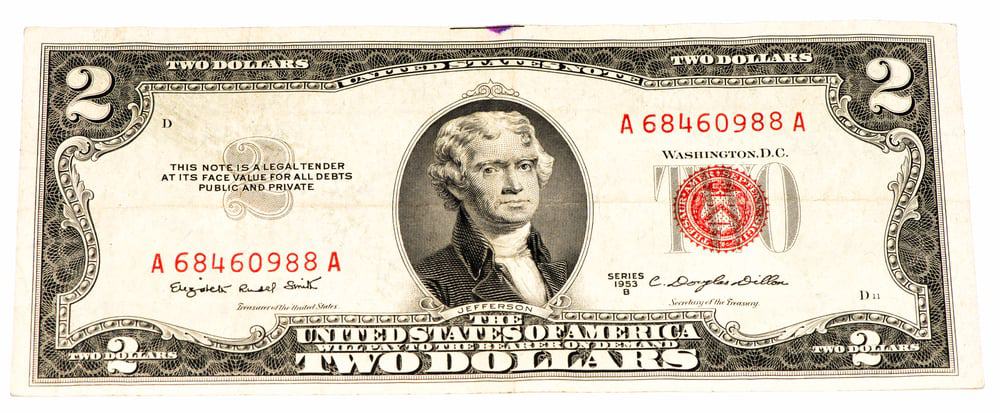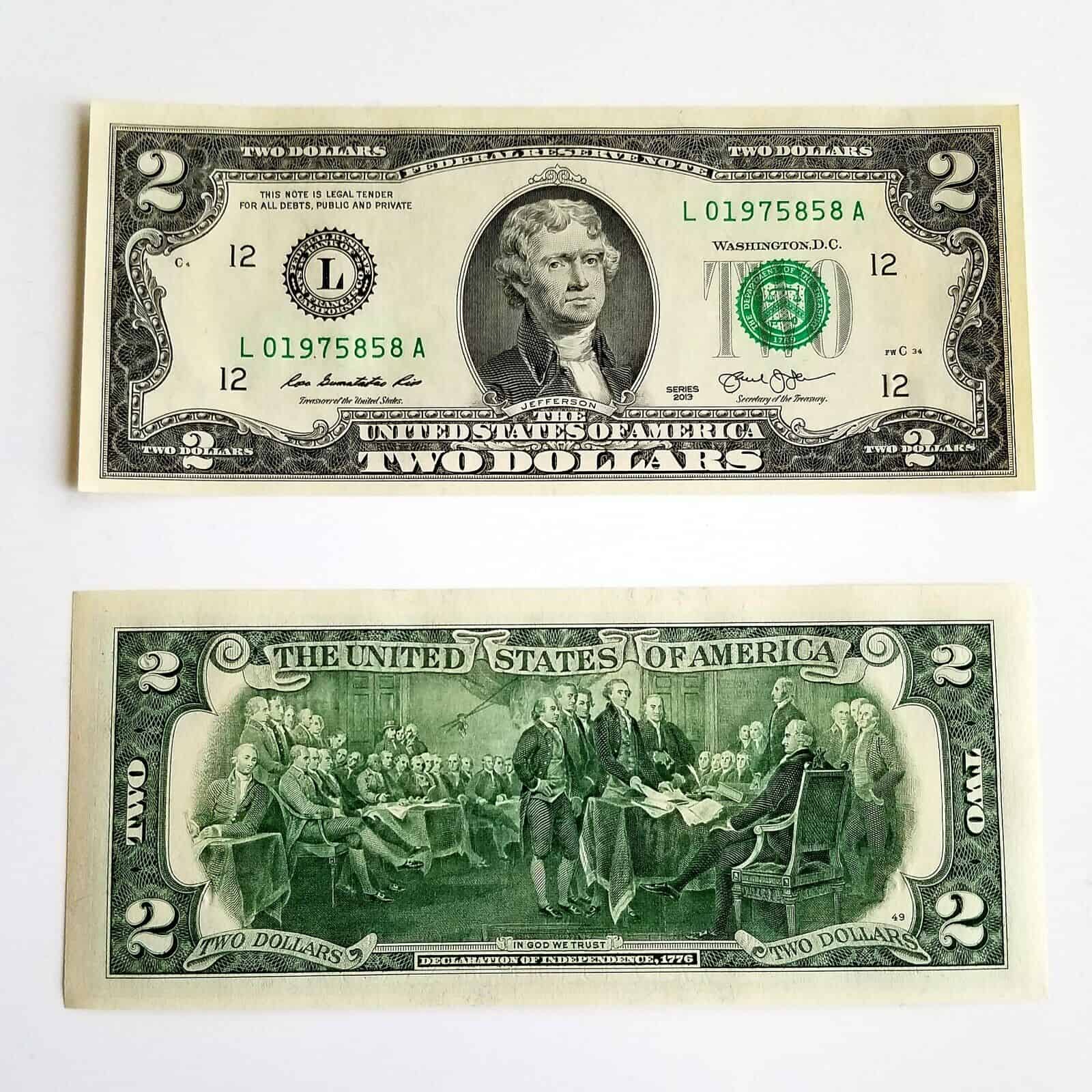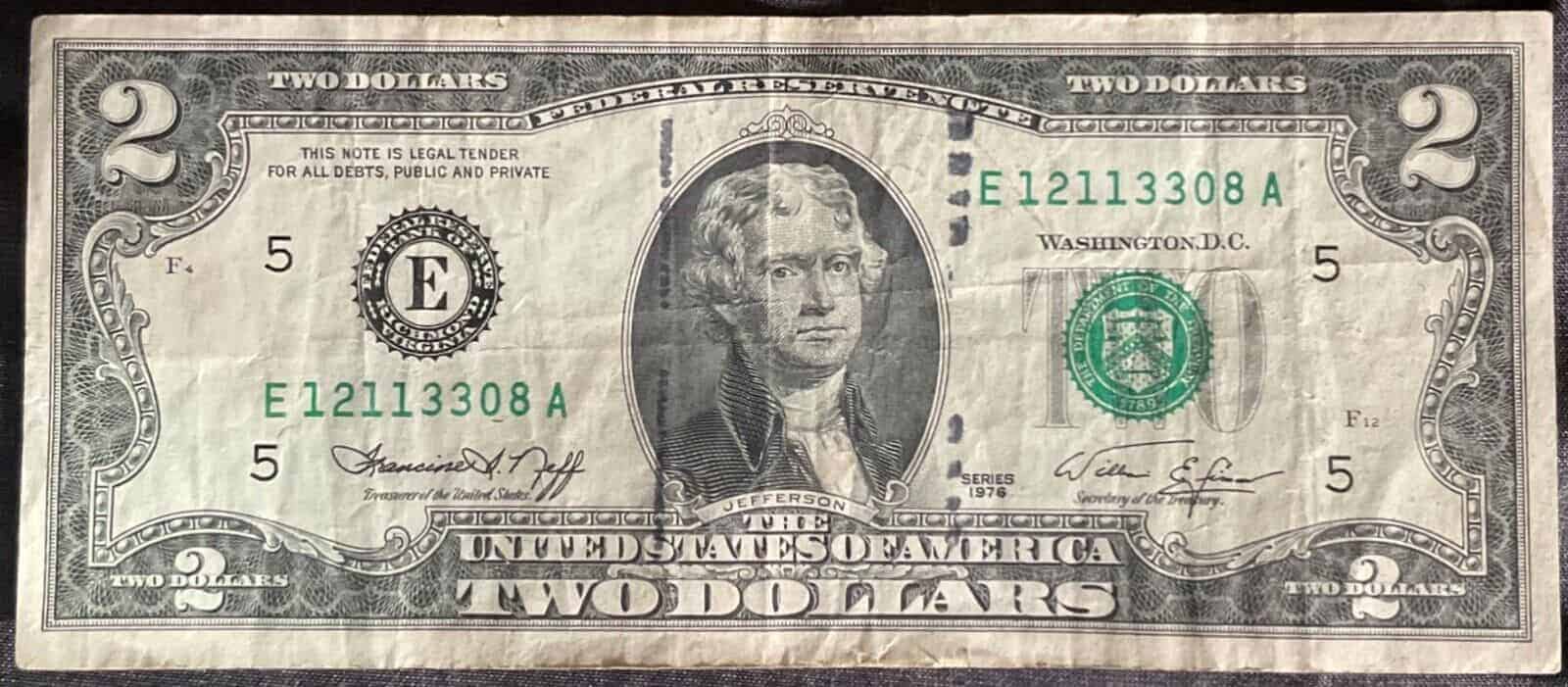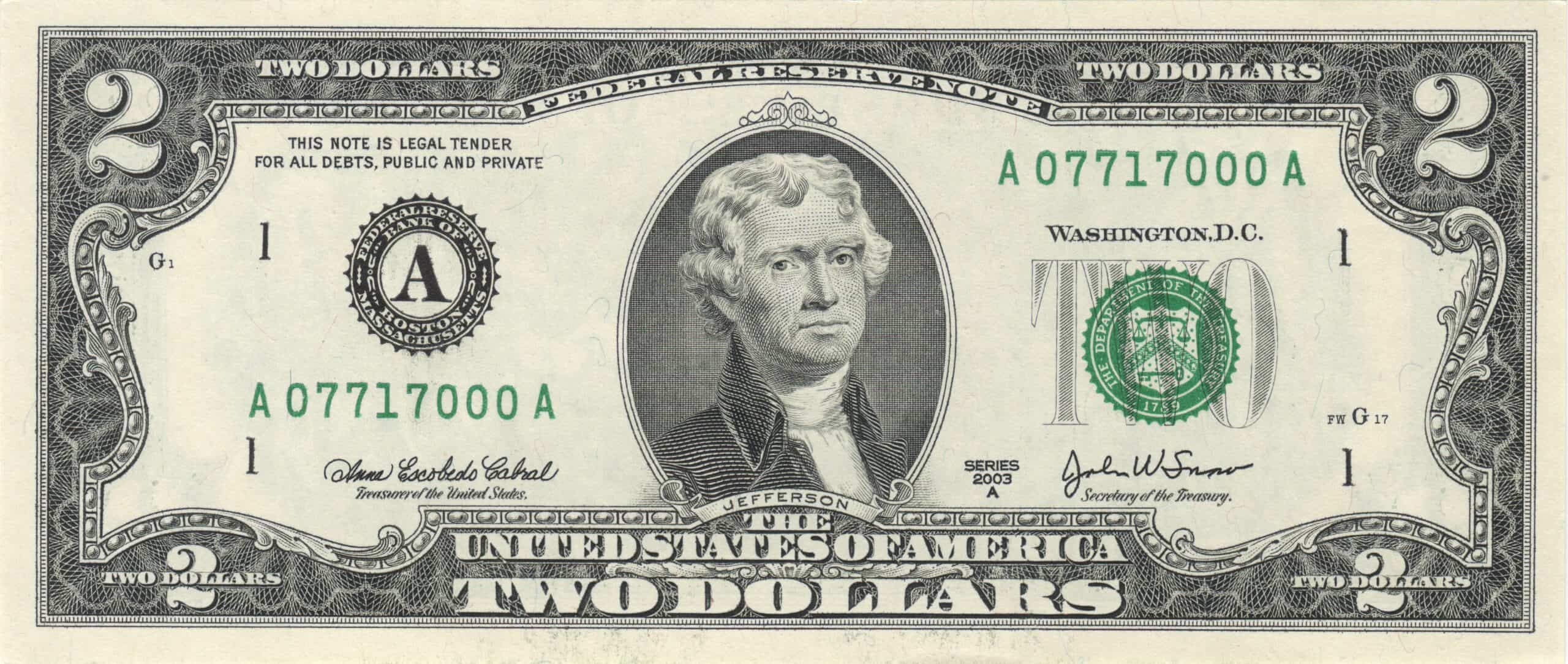How Much is a $2 Dollar Bill Worth? (Full Value Guides)

Did you know $2 Bills are alive and well in the USA today? Most people think they’re fake and some have been arrested for using them at stores, gas stations, and even schools! But the $2 Bill is legal tender, and you can pick one up at almost any bank. How much is a 2 Dollar Bill worth? In most cases, $2. But some special bank notes can be worth thousands or more!
2 Dollar Bill Price Tables
How much is a $2 Bill worth? That depends on various factors like its condition, production date, mintage volume, printing location, verified errors, and several others. We’re going to look at each criterion in detail, but let’s start by glancing at the prices of a few $2 Bills across the centuries. We’ll include the date of the sale so you can assess the figures by their recency.
$2 Bill Value Chart |
|||||
| $2 Bill Series | District/
Branch |
Seal Color | Date of Sale | Grade | Price |
| Fr. 1937-E* 2003 $2 | Richmond | Green | 5th April 2022 | 65 EPQ Gem Uncirculated | $20,400 |
| Fr. 48 1878 $2 | – | Red | 31st October 2018 | 63 PPQ
Choice |
$1,740 |
| Fr. 387A Lazy Deuce 1875 $2 (Woman) | New York | Red | 23rd August 2018 | 35 PPQ
Very Fine |
$9,000 |
| Fr. 1940-L*
Radar Serial No. 2013 $2 |
San Francisco | Green | 12th January 2022 | 66 PPQ
Gem |
$384 |
| Alexander Hamilton Fr. 41A 1862 $2 | New York | Red | 19th March 2020 | 66 EPQ Gem Uncirculated | $24,000 |
| Winfield Hancock Silver Certificate Fr. 242 1886 $2 | – | Red | 4th March 2019 | 67 PPQ
Superb Gem |
$9,000 |
| Fr. 248 Educational Silver Certificate 1896 $2 (Women) | – | Red | 31st October 2018 | 67 PPQ
Superb Gem |
$15,600 |
| Fr. 1935-C Solid #1s Serial No. 1976 $2 | Philadelphia | Red | 25th August 2023 | 64 EPQ Choice Uncirculated | $8,400 |
| Fr. 1939-K Solid #1s Serial No. 2009 $2 | Dallas | Green | 14th August 2019 | Extremely Fine 40 | $3,120 |
| Fr. 42 1869 $2 | – | Red | 27th March 2018 | 64 PPQ
Choice |
$8,100 |
| Boston The Market Bank 18xx $2 | Boston | – | 14th November 2017 | Choice Uncirculated Proof | $1,440 |
| Sheboygan, Wisconsin, The German Bank 1863 $2 (Women) | – | – | 12th August 2014 | Choice
Fine |
$3,525 |
| Silver Certificate 1899 $2 | – | Blue | 25th August 2023 | 66 EPQ Gem Uncirculated | $6,600 |
The History of the $2 Bill

$2 Bills were introduced in 1862. The first one featured Alexander Hamilton. Yes, the one from the musical. He was a Founding Father and became the first Secretary of the Treasury when we gained our independence from the British. He was in office from 1789 to 1795 so he played a big role when we opened the Philadelphia Mint to make our own currency in 1792.
But by 1869, Hamilton had been replaced on the $2 Bill. He ceded his position on the note to Thomas Jefferson, the 3rd US President. The bank note went through tons of redesigns and iterations, with periods featuring other subjects like Winfield Scott Hancock, Robert Fulton, James McPherson, George Washington, William Windom, Samuel Morse, and Lazy Deuce.
The Woman on the $2 Bill from 1875
The latter got its name from a woman with a flag that had a ‘Lazy 2’ lying on its side. But by 1928, Jefferson was back on the $2 Bill, which is why some people call them Toms. Sadly. The notes got a bad rap because they were used in situations that were less … socially acceptable e.g. gambling, strip clubs, and bribes. But they were also used to make an economic point.
On at least three separate occasions, the $2 Bill became a key financial metric. It was used by soldiers in World War II, Steel Workers in Geneva (Utah), and sports fans in South Carolina. In all these case studies, the spread of $2 Bills within the community showed the importance and spending power of these groups. But let’s talk a little more about the technical aspects.
How $2 Bills Are Made
Most of the time, the date on a coin shows the year it was minted. There are some exceptions. For example, over a million Washington Quarters made from 1964 to 1966 were dated 1964 to prevent hoarding. But coins use dies that wear out after striking a few hundred thousand coins. Conversely, $2 Bills are made using face plates and back plates that last much longer.
These plates are placed on boards and overlaid with printing paper. Then, inked impression cylinders roll over the paper to transfer the design. The first pass prints the back or reverse of the note in green. The second pass does the front in black, also known as the obverse. The final pass imprints the seals and serial numbers onto the obverse, often using colored ink.
Printing Plates vs. Coin Dies
This means printing plates can be used millions of times before they’re phased out. Usually, they’re only changed when a new set of signatures is added to the note. These signatories are the Secretary of the Treasury and the US Treasurer. From 1861 to 1923, the Register of the Treasury would sometimes sign bank notes as well. But the design often stayed the same.
Therefore, if a $2 Bill had the same design but a new Secretary, Treasurer, or Register had been appointed, the face plate was altered to replace the signatory. And a pair of plates could be used for years or even decades. To keep records reliable, these designs were numbered by the year when their design was initially approved, with an alphabetical letter for alterations.
How $2 Bills Are Classified

This system means the current $2 Bill (which was launched in 1976 after a ten-year hiatus) has retained its obverse and reverse but has cycled through seven pairs of signatories below:
- The 1976 Series signed by William Edward Simon and Francine Irving Neff.
- The 1995 Series signed by Robert Edward Rubin and Mary Ellen Hinamon Withrow.
- The 2003 Series signed by John William Snow and Rosario Marin.
- The 2003A Series signed by John William Snow and Anna Escobedo Cabral.
- The 2009 Series signed by Timothy Franz Geithner and Rosa Gumataotao Rios.
- The 2013 Series signed by Jacob Joseph Lew and Rosa Gumataotao Rios.
- The 2017A Series signed by Steven Turner Mnuchin and Jovita Carranza.
You’ll notice they ‘skipped’ the 2017 and went straight to 2017A. That’s because the 2017 Series was also signed by Mnuchin and Carranza, but it didn’t include the $2 denomination.
Instead, the 2017A was a set of replacement star notes, which we’ll look at later in the Star Notes section. In addition to the series date, $2 Bills and other modern American notes can be classified by their Fr. Number. This comes from Robert Friedberg who wrote a book in 1953. His book cataloged modern paper money, assigning Friedberg Numbers to each note.
The name of the book is Paper Money of the United States, and his sons Ira and Arthur have updated it over the years. This means when you’re studying, collecting, or evaluating $2 Bills, you’ll use the Fr. Number, series date, and condition to confirm how much a $2 Bill is worth. The Fr. Number typically includes a letter of the alphabet to identify the 12 Federal Districts.
Federal Districts or Branches on $2 Bills
Since it opened in 1792, the US Mint has had eight branches. Four are still active today. But these mint branches focus on coin-making. On the other hand, US bank notes are printed in Washington DC and Fort Worth, Texas. Since the 1995 Series, $2 Bills are exclusively printed at Fort Worth. You’ll see a tiny FW next to the face plate number on the lower right obverse.
That said, the Federal Reserve Bank has 12 Districts or Branches. Each one is identified by a letter from A to H and a number from 1 to 12. And $2 Bills show this information through a round seal and a number on the front of the bank note. On modern notes (after 1976), it was on the left and comprised several black concentric circles with a serrated edge on the outside.
Understanding District Seals on $2 Bills
The middle circle held the initial while the outer circles spelled the Federal Reserve city and state e.g. K for Dallas, Texas. The district number also appears at the beginning of all serial numbers. Meanwhile, the corresponding district number is printed four times on the front of the note. Below is a list of the 12 Districts or Branches with their designated letters and numbers.
- Boston, Massachusetts – A1
- New York City, New York – B2
- Philadelphia, Pennsylvania – C3
- Cleveland, Ohio – D4
- Richmond, Virginia – E5
- Atlanta, Georgia – F6
- Chicago, Illinois – G7
- Louis, Missouri – H8
- Minneapolis, Minnesota – I9
- Kansas City, Missouri – J10
- Dallas, Texas – K11
- San Francisco, California – H12
Don’t confuse these district letters and numbers for the face plate position, which appears in tiny print on the inner top left of the note. That’s a different marker that shows where it was located on the printing plate. Before 2014, these plates were divided into four quadrants with eight notes each e.g. H3. After 2014, they used 50 notes per plate in 10 rows and 5 columns.
These positions appeared on uncut sheets of $2 Bills so the letter and number showed which segment the note came from. It’s an administrative metric, and the inner bottom left of the note has the same face plate number, sometimes with a different segment, and often with FW in front of it for Fort Worth notes. As we said before, all notes after 1995 are from Fort Worth.
Colored Seals on $2 Bills

The most expensive $2 Bills have red seals, and all modern $2 Bills have lighter green seals. But what does this all mean? The second seal, which is on the left of older notes and the right of newer ones – is the official stamp of the Treasury Department. Each color has a different significance, so let’s look at some of them and briefly explain how they impact $2 Bill values.
- Old Red Seals – Series 1862 to 1878 – United States Notes
- Old Blue Seal – Series 1899 – Silver Certificate Redeemable in Silver Dollars
- New Blue Seal – Series 1918 – Federal Reserve Note not Redeemable in Silver
- New Red Seal – Series 1928 to 1963A – Legal Tender Note
- Old Dark Green Seal – Federal Reserve Note with Latin Text
- New Light Green Seal – Federal Reserve Note with English Text
The Treasury Seal is a shield with the scales of justice in its upper segment and a key in its lower segment. The shield sits inside concentric circles with a scalloped or serrated outer edge. The serial number on your $2 Bill is printed in the same color as the seal. While all modern bank notes have green seals, earlier notes were sometimes altered temporarily.
Star Notes, Errors, and Fancy Serial Numbers on $2 Bills
A mint error can increase the value of any note or coin. That’s why major mint mistakes are recorded by experts. Some collectors focus on error notes and will pay vast sums for them. But the BEP (Bureau of Printing and Engraving) doesn’t handle bank note errors the same way that the US Mint deals with coin errors. With bank notes, errors are instantly replaced.
The replacement note will have the same serial number, but instead of starting or ending with an alphabetical letter, it will have a star. The BEP often sells these star notes in batches as special editions. But you can still find one in the wild, so keep a close eye out! As for the mistakes that escape the mint without being replaced, common errors include folds and cuts.
You might also get spilled ink, wrong color combinations, misaligned serial numbers, and mismatched serial numbers. That’s when the figures on the upper right and lower left aren’t identical. Speaking of serial numbers, study them for extra value. Serial numbers that have low digits, high digits, repeat sequences, or significant calendar dates can be quite profitable.
The True Value of the $2 Bill
By combining all the factors we’ve discussed, you can figure out how much a $2 is worth. As we said, most are only worth their $2 face value. But if you find older notes in high grades of Choice, Gem, or Superb Gem 63 to 70, you can make a lot of money. Focus on errors, serial numbers, seal colors, and visual appeal. Then decide if they’re worth submitting to PMG.
